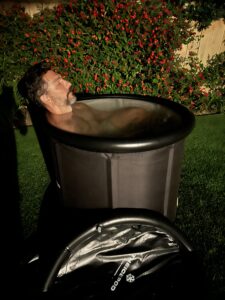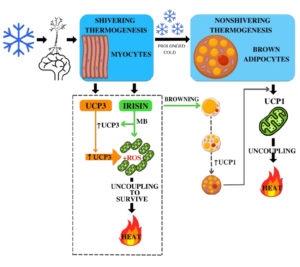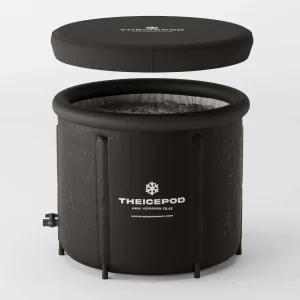The Truth About Ice Baths
 Cold plunges and ice baths have gotten incredibly popular over the past few years. Personally, I really love the benefits from doing cold water immersion, but a lot of the information that is being put out can be very misleading.
Cold plunges and ice baths have gotten incredibly popular over the past few years. Personally, I really love the benefits from doing cold water immersion, but a lot of the information that is being put out can be very misleading.
I wanted to share some of my personal experiences with ice baths and look at some of the proposed benefits out there, so you can make the decision if this is something that is right or not for you.
The hard part about all of this, is there is not as much research on specifically what you think of when you hear ice baths. For example, a lot of the studies that are referenced involve winter swimming seasons, where swimmers are regularly exposed to cold water (and cold weather in general) for longer durations. This may not have the same effects as a 10 minute bath. That doesn’t mean there aren’t any benefits, it is just hard to stay with certain everything that is going on. But understanding some human physiology and the available research we can at least make educated guesses on what is going on when we expose the body to cold.
First off, cold plunges, cold showers, and whole body cryotherapy are all different. There might be some similar effects, but they are not the same thing. For the purposes of this article I am going to focus specifically on cold water immersion.
The main proclaimed benefits of cold exposure include:
- Increase immunity
- Improving depression
- Enhanced circulation
- Increased metabolism
- Improved sleep
- Stress reduction
- Exercise recovery
- Increased endurance performance
Next, let’s look at what happens to human physiology when the body is exposed to cold. The body wants to closely regulate the internal environment, temperature being one thing it tries to maintain to avoid death. When you get in cold water, there is a shock to the central nervous system and in response an increase in sympathetic nervous system activity. In order to avoid heat loss, blood is diverted to the internal organs through vasoconstriction. After about 5-10 minutes blood vessels begin to vasodilate and then vasoconstrict again repeating in a cyclic fashion, which may improve circulation.
 If we are in cold for long enough, this isn’t enough to manage core temperature, so the body has to find other ways to create heat. This is done through shivering and nonshivering thermogenesis. Muscle can create more heat through energy expenditure so the nervous system causes rapid involuntary muscle contractions (shivering) in order to expend energy and create heat. Your metabolic rate is 5 times higher when shivering versus resting metabolism.
If we are in cold for long enough, this isn’t enough to manage core temperature, so the body has to find other ways to create heat. This is done through shivering and nonshivering thermogenesis. Muscle can create more heat through energy expenditure so the nervous system causes rapid involuntary muscle contractions (shivering) in order to expend energy and create heat. Your metabolic rate is 5 times higher when shivering versus resting metabolism.
So yes, cold exposure can increase your metabolism. But keep in mind a normal workout session will burn way more calories in the same time as sitting in an ice bath.
The body also creates heat through nonshivering thermogenesis. This is where brown adipose tissue (BAT) comes in. This type of fat gets a lot of attention, because it has a lot more mitochondria than white adipose tissue and it is much more metabolically active. Humans do not have a lot of BAT but it is still present and during cold exposure, in order to create heat, blood flow is sent to BAT and there is an increase in glucose and fatty acid consumption. There are claims that you increase the amount of BAT or white adipose tissue turns to brown, but there isn’t clear evidence of this. What is more likely is the BAT you have is becoming more active.
This not only increases energy expenditure, but might be helpful improving insulin sensitivity and used as a treatment for Type II diabetes. On a similar note, research has shown improvements in cardiovascular risk factors such as ApoB/ApoA1 ratio and oxidative stress markers after regular cold exposure.
With claims that you will burn a ton of calories with cold plunges though we have to be careful. This should be be considered a main way to burn calories in terms of body composition. Instead it might improve fuel selection by improving insulin sensitivity and improving other risk factors of cardiovascular disease. Not as a magic fat burning trick.
As mentioned cold exposure is a shock to the system. This shock initiates a stress response. This stress response increases immune response by sending out white blood cells and antioxidants. This helps deal with inflammation. Regular exposure improves this process making the body more protective and better able to handle stress.
In terms of mental state and pain, there is some promising research but still more is needed for any clear conclusions. One case study used cold water immersion to help get a patient off of antidepressants. Another used patients suffering from fibromyalgia or asthma where all subjects reported pain relief, positive mood, and improved memory. This is potentially a simple thing to add to what you may be doing for improving mental state. Try adding it to see how it improves but don’t rely on it to fix everything. Mental state and cognitive health are multidimensional and will likely require a multifaceted approach.
In terms of exercise, cold therapy has been shown to have a number of positive benefits. Cold exposure after training showed faster recovery times compared to non therapy. Research has shown improvements in sprint performance, muscle function, muscle soreness, markers of muscle damage, inflammation, and oxidative stress. One word of caution though. If strength and muscle size are the goal, then blunting these signals after a workout are not what you want. This will slow the effects of training. So it is best to avoid cold water immersion for several hours post strength training. If you are using it to recovery quicker for the next day though it would be helpful. For example if you had back to back races, you could use this to recover faster for the next day.
Endurance training is a different story. Cold exposure may increase mitochondrial biogenesis which may aid in endurance performance. So it is ideal to do cold exposure post endurance training sessions.
An interesting side note, if you submerge your head in cold, there is a diving response that may have some benefits. Holding your breath and wetting/cooling the face and nostrils will stimulate this response. This will do a number of things, but there will be a release of red blood cells from the spleen, potentially increases red blood cell count. HOWEVER, this can also result in respiratory gasping, uncontrollable hyperventilation, and hypertension. There have been reported incidence of cardiac arrhythmias when submerged in cold water. Please take extreme caution if submerging your head. For more this would not be recommended, especially if you have higher blood pressure.
As you can see there is a lot of evidence of the benefits of cold exposure. But keep in mind these are small effects that won’t do much on their own. These will contribute greatly for those already doing other things to improve their health. Despite the claims, just getting in cold water will do very little for pushing the needle towards better health. It isn’t until you combine this with the essentials that you start to see more significant improvements.
Just doing ice baths without a good diet, sleep, and exercise plan, would be like taking a multivitamin each day, but eating fast food for every meal. It is a piece of the plan, but not the whole plan.
So how should you incorporate this if you are ready? Start small. Colder is not better and too cold may have negative health effects. I see no reason to use anything colder than 50 degrees, but sometimes you don’t have control of the temperature. Start around 60 degrees for as long as you can. Remember the research uses longer exposure of up to hours. A good goal would be 50-60 degrees for 10-15 minutes. We need time in the water to really get the physiological benefits. The colder you go the shorter the time, but if you go too cold and too short, I think you are missing out on a lot of the benefits.
I hope this clears some things up for you. I have seen some pretty crazy claims on cold plunges. They aren’t magical, but they do have a ton of potential benefits if you are doing a lot of other things with it. Personally, I have noticed I sleep much better on days I do it (especially how quickly I fall asleep). While it is always tough to get into them I do feel amazing when I get out. Many say you should do it in the morning, but due to may schedule I can’t only do it in the late afternoon and evening. This still leads to better nights sleep for me. I also do like to take a hot shower after. Some claim you should end on cold, but I haven’t seen anything really to support that. Maybe you are burning more calories for longer to naturally let yourself warm up, but remember we are talking about such a small number of calories, it really isn’t relevant.
For those that take cold showers, I don’t think you can claim most of these benefits listed above. I don’t think cold showers are bad, but in order to get the positive effects you need to get cold enough for long enough. While cold showers feel uncomfortable, you aren’t able to accomplish this. If you feel great doing them and are noticing positive benefits then keep doing them. It just isn’t the same as cold plunges.
 If you want to add cold water immersion to your routine, check out the Ice Pod Pro from the Pod Company. I am an affiliate so I do make a couple bucks if you purchase through the link below. It is a great product at an incredible price too.
If you want to add cold water immersion to your routine, check out the Ice Pod Pro from the Pod Company. I am an affiliate so I do make a couple bucks if you purchase through the link below. It is a great product at an incredible price too.
https://snwbl.io/pod-company/MIKE17290
Keep training smarter.
Mike Deibler
Reference:

